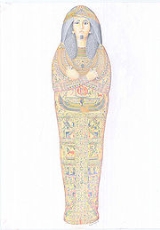
Nesyamun
Encyclopedia

Ancient Egypt
Ancient Egypt was an ancient civilization of Northeastern Africa, concentrated along the lower reaches of the Nile River in what is now the modern country of Egypt. Egyptian civilization coalesced around 3150 BC with the political unification of Upper and Lower Egypt under the first pharaoh...
ian temple
Egyptian temple
Egyptian temples were built for the official worship of the gods and commemoration of pharaohs in Ancient Egypt and in regions under Egyptian control. These temples were seen as houses for the gods or kings to whom they were dedicated...
complex at Karnak
Karnak
The Karnak Temple Complex—usually called Karnak—comprises a vast mix of decayed temples, chapels, pylons, and other buildings, notably the Great Temple of Amun and a massive structure begun by Pharaoh Ramses II . Sacred Lake is part of the site as well. It is located near Luxor, some...
and died over 3,000 years ago, around 1100 BC. His body was then preserved and entombed ready for the after-life. Ever since he arrived at the Leeds
Leeds
Leeds is a city and metropolitan borough in West Yorkshire, England. In 2001 Leeds' main urban subdivision had a population of 443,247, while the entire city has a population of 798,800 , making it the 30th-most populous city in the European Union.Leeds is the cultural, financial and commercial...
City Museum
Leeds City Museum
Leeds City Museum, originally established in 1819, re-opened on 13 September 2008 in Leeds, West Yorkshire, England. It is housed in the former Mechanics' Institute built by Cuthbert Brodrick, in Millennium Square, which has been redeveloped to a design by Austin-Smith:Lord architects and Buro...
in 1823, he has been recognized as one of the most remarkable mummies
Mummy
A mummy is a body, human or animal, whose skin and organs have been preserved by either intentional or incidental exposure to chemicals, extreme coldness , very low humidity, or lack of air when bodies are submerged in bogs, so that the recovered body will not decay further if kept in cool and dry...
in Britain.
In 1990 the Director of Leeds City Museum invited Dr. Rosalie David, (now Professor), to undertake a new scientific study of the mummy of Nesyamun. this multi-disciplinary team was set up in 1973 to discover more about the living conditions, diseases, and causes of death of the ancient Egyptian population, and also to establish formal non-destructive methods of examining mummified remains. The International Mummy Database founded at the Manchester Museum in 1979 is now recognized as the major center for the collection and storage of mummy-related information from all over the world.
Since 2002, Leeds Museum have been documenting and researching both the decoration upon the coffin, and the coffin itself. This has led to a greater understanding of the nature of the roles that Nesyamun, as a priest at the temple of Karnak
Karnak
The Karnak Temple Complex—usually called Karnak—comprises a vast mix of decayed temples, chapels, pylons, and other buildings, notably the Great Temple of Amun and a massive structure begun by Pharaoh Ramses II . Sacred Lake is part of the site as well. It is located near Luxor, some...
, would have adopted.
On September 4 2008, the mummy was moved to a new home at Leeds City Museum.

